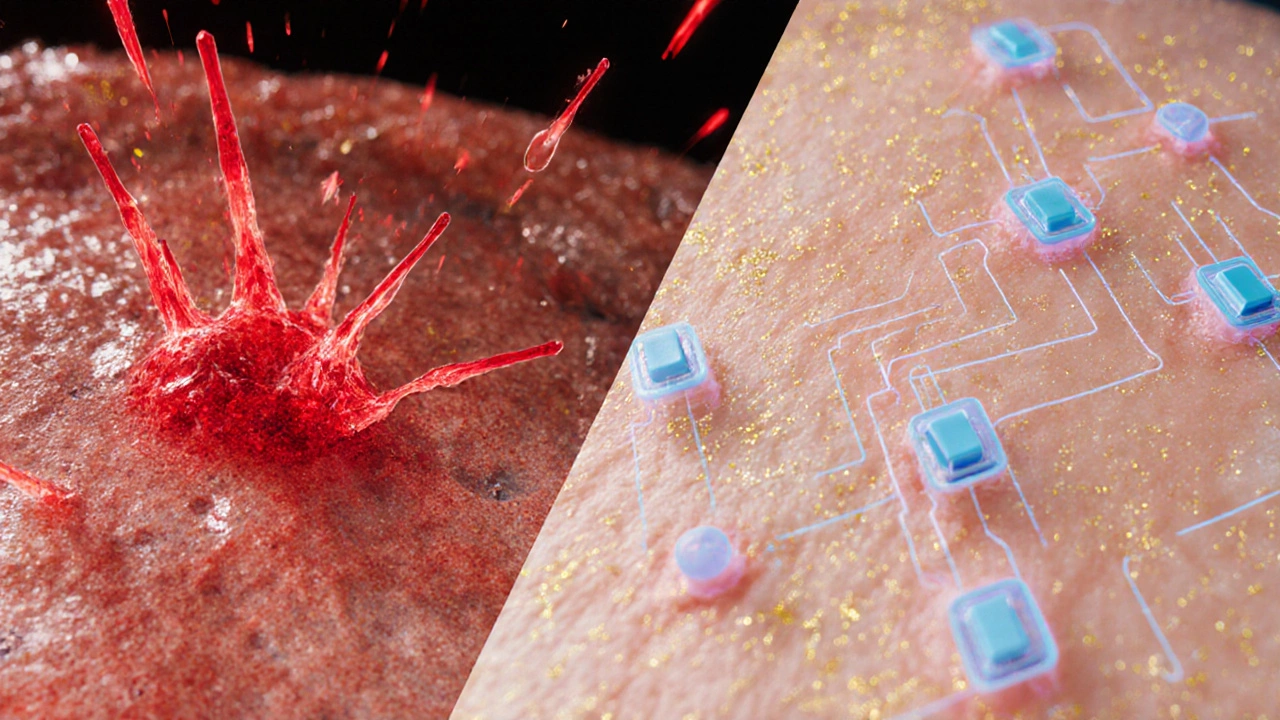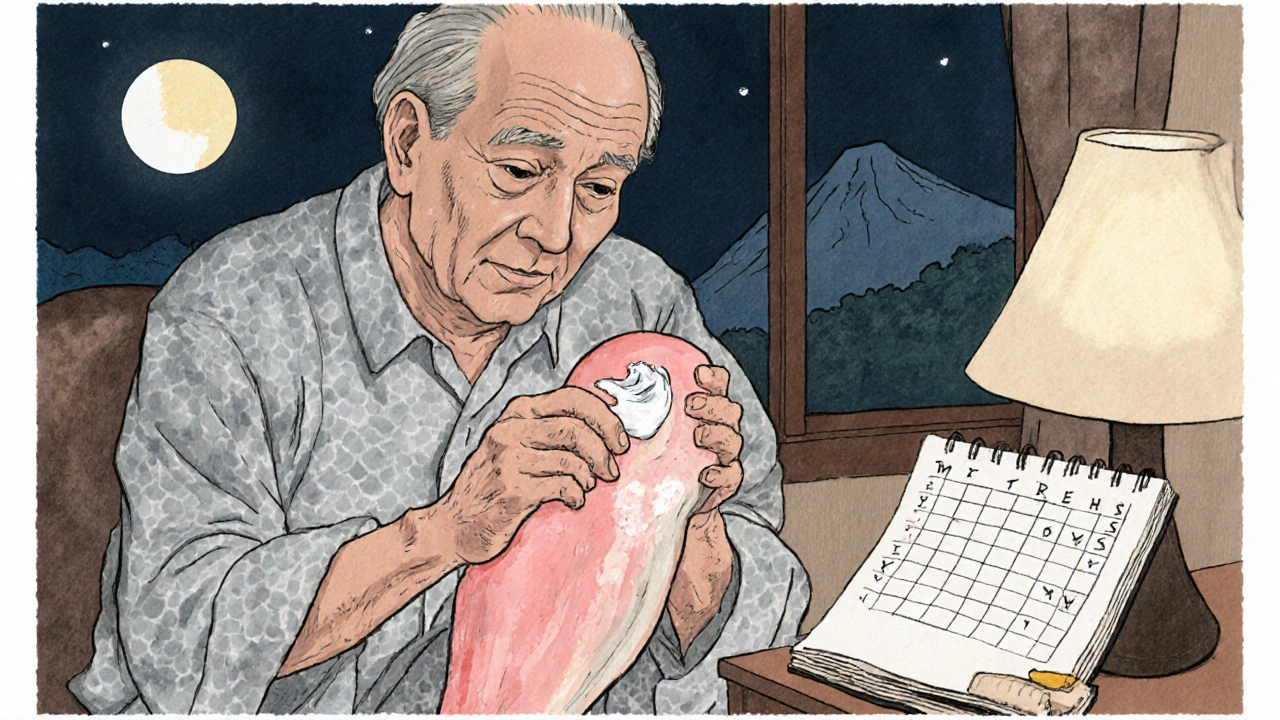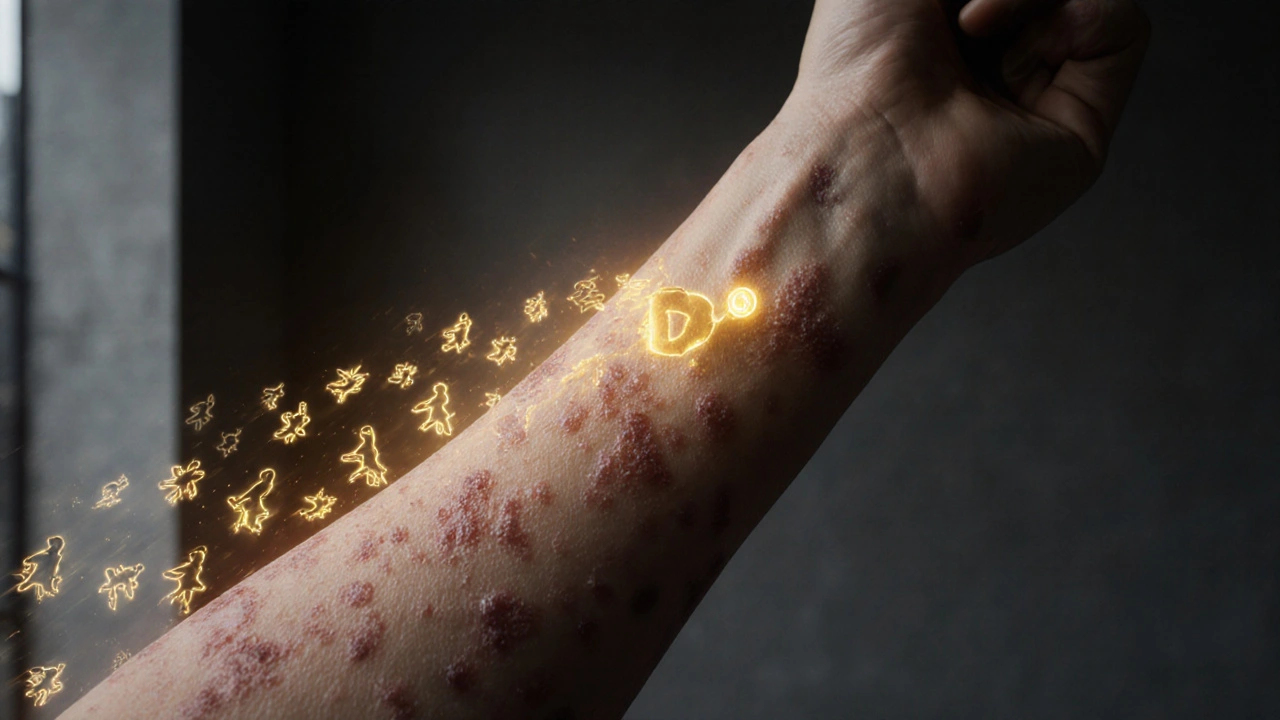Calcipotriene isn’t just another cream you slap on your skin. It’s a targeted drug designed to reset the runaway cell growth that turns psoriasis into red, scaly patches. If you’ve ever stared at a patch of flaking skin and wondered how a simple ointment could make a difference, the answer lies in how calcipotriene talks to your body’s own biology - not by killing cells, but by retraining them.
What Calcipotriene Actually Is
Calcipotriene is a synthetic version of vitamin D3, specifically made to mimic the active form your body uses to regulate skin cell production. Unlike natural vitamin D from sunlight or food, calcipotriene is engineered to act only on the skin. It doesn’t raise calcium levels in your blood like oral vitamin D supplements can. That’s why it’s safe to use topically - your body treats it like a local messenger, not a systemic hormone.
It was first approved in the early 1990s and quickly became a go-to for mild to moderate plaque psoriasis. Today, it’s still one of the most prescribed topical treatments worldwide. In Australia, it’s available by prescription under brand names like Dovonex and as generics. You’ll find it in ointments, creams, and solutions - each formulation chosen based on where the plaques are and how dry or thick the skin is.
How It Stops Psoriasis in Its Tracks
Psoriasis isn’t an infection. It’s not caused by dirt or poor hygiene. It’s an autoimmune glitch where your immune system sends false signals that tell skin cells to multiply too fast. Normal skin cells take about 28 days to rise to the surface and shed. In psoriasis, that process speeds up to just 3-7 days. The result? A pile-up of dead cells forming thick, silvery scales.
Calcipotriene steps in by binding to vitamin D receptors on skin cells - called keratinocytes. Once attached, it flips a genetic switch that slows down cell division. It doesn’t kill cells. It doesn’t burn them off. It simply tells them to slow down and behave like normal skin cells again.
It also calms inflammation. Psoriasis plaques aren’t just scaly - they’re red, warm, and often itchy or sore. Calcipotriene reduces the production of inflammatory chemicals like TNF-alpha and interleukin-17. These are the same molecules targeted by expensive biologic drugs. So calcipotriene does some of the heavy lifting of advanced treatments, but with a simple cream.
Why It Works Better Than Steroids Alone
Many people use calcipotriene alongside corticosteroids - and for good reason. Steroids reduce inflammation fast, but they don’t fix the root problem: overactive skin cells. Left alone, steroids can thin the skin over time, especially on the face or folds. Calcipotriene doesn’t have that risk.
Studies from the British Journal of Dermatology show that combining calcipotriene with a low-potency steroid leads to faster clearing of plaques than either treatment alone. In one trial, 72% of patients saw at least a 75% improvement in their Psoriasis Area and Severity Index (PASI) after eight weeks of combination therapy. That’s more than double the rate seen with steroid-only use.
Doctors often recommend using the steroid in the morning and calcipotriene at night. This avoids the chemical interaction that can make calcipotriene less stable when mixed in the same tube. It also gives each drug time to do its job without interference.

What Happens When You Use It
Don’t expect overnight results. Calcipotriene works slowly because it’s fixing a biological process, not masking symptoms. Most people start seeing lighter plaques and less scaling after two to four weeks. Full improvement usually takes six to eight weeks. If you stop too early, you’ll lose progress.
Some users report mild stinging or burning right after application - especially on cracked or inflamed skin. That usually fades after a few days. If it doesn’t, or if your skin starts peeling more than usual, you might be using too much. The recommended dose is a thin layer applied twice daily to affected areas - no more than 100 grams per week. Overuse can cause high calcium levels in the blood, though that’s rare with proper use.
It’s also not meant for the face unless specifically directed. The skin there is thinner and more sensitive. For facial psoriasis, doctors often switch to a milder vitamin D analog like tacalcitol or recommend non-medicated moisturizers.
Who Should Avoid It
Calcipotriene is safe for most adults and children over 12. But it’s not for everyone. If you have a known allergy to vitamin D or any ingredient in the cream, skip it. People with calcium metabolism disorders - like hypercalcemia or kidney disease - should use it only under close supervision.
Pregnant or breastfeeding women are often advised to avoid it unless benefits clearly outweigh risks. While animal studies haven’t shown birth defects, human data is limited. Always talk to your doctor before using any medication during pregnancy.
And while it’s fine for long-term use, calcipotriene isn’t a cure. Psoriasis is chronic. Stopping treatment usually means plaques return. That’s why many people use it in cycles - apply it until plaques clear, then reduce frequency to once a week or every other day as maintenance.

How It Compares to Other Topical Options
| Treatment | How It Works | Time to See Results | Common Side Effects | Long-Term Safety |
|---|---|---|---|---|
| Calcipotriene | Slows skin cell growth, reduces inflammation | 2-8 weeks | Mild stinging, dryness | High - no skin thinning |
| Corticosteroids | Suppresses immune response | 1-2 weeks | Thinning skin, stretch marks | Low - avoid long-term use |
| Tazarotene (retinoid) | Normalizes cell turnover | 4-12 weeks | Redness, peeling, irritation | Moderate - can be drying |
| Coal Tar | Slows cell growth, reduces scaling | 4-8 weeks | Odor, staining, sensitivity to sun | Moderate - potential carcinogen with heavy use |
| Anthralin | Slows cell production | 2-6 weeks | Severe irritation, staining | Moderate - hard to use consistently |
What makes calcipotriene stand out? It doesn’t stain clothes. It doesn’t smell. It doesn’t require special application techniques. And unlike coal tar or anthralin, you can use it on your scalp, elbows, and knees without worrying about mess or embarrassment.
Real-Life Use: What Patients Say
In Melbourne, dermatologists report that patients who stick with calcipotriene for at least six weeks often see dramatic changes. One 42-year-old teacher, who’d struggled with elbow plaques for 12 years, told her doctor: “I stopped wearing long sleeves in summer. I didn’t think I ever would again.”
Another patient, a 68-year-old retired carpenter, used calcipotriene after a knee replacement when psoriasis flared from stress. He applied it nightly, kept a log of his plaques, and within ten weeks, his skin looked almost normal. He still uses it once a week to stay clear.
These aren’t outliers. They’re the rule when treatment is consistent. The biggest reason people quit? Expecting magic. Calcipotriene doesn’t work like a painkiller. It’s more like a gardener - slowly pruning back the overgrowth until the healthy plant can thrive again.
What Comes After Calcipotriene?
If calcipotriene doesn’t work after 8-12 weeks, your doctor might suggest switching to another topical, adding phototherapy, or moving to a systemic treatment. But that doesn’t mean calcipotriene failed. It means your body needed a different tool.
Some people use it for years. Others use it in rotation - three months on, one month off. There’s no single path with psoriasis. The goal isn’t perfection. It’s control. And calcipotriene gives you that without the cost or risks of injections or pills.
It’s not glamorous. It’s not trendy. But for millions, it’s the quiet hero that lets them live without shame, without covering up, without wondering if they’ll ever feel normal again.
Can calcipotriene cure psoriasis?
No, calcipotriene doesn’t cure psoriasis. It controls the symptoms by slowing skin cell growth and reducing inflammation. Psoriasis is a chronic condition, so symptoms usually return if treatment stops. But many people maintain clear skin with regular, low-dose use.
How long does it take for calcipotriene to work?
Most people start noticing improvement in 2-4 weeks, with full results typically seen by 6-8 weeks. Patience is key - it’s not an instant solution. Stopping too early can mean losing progress.
Can I use calcipotriene on my face?
Generally, no - unless your doctor specifically says so. The skin on your face is thinner and more sensitive. Using calcipotriene there can cause irritation or redness. For facial psoriasis, alternatives like tacalcitol or gentle moisturizers are safer.
Is calcipotriene safe for long-term use?
Yes, calcipotriene is considered safe for long-term use. Unlike corticosteroids, it doesn’t thin the skin or cause stretch marks. The main risk is overuse - applying more than 100 grams per week - which can raise blood calcium levels. Stick to the prescribed amount and avoid large areas unless directed.
Can children use calcipotriene?
Yes, calcipotriene is approved for children aged 12 and older. For younger children, doctors may prescribe alternative treatments due to limited safety data. Always follow your doctor’s dosing instructions carefully.
Does calcipotriene cause skin cancer?
No, there’s no evidence that calcipotriene causes skin cancer. Unlike UV light therapy or certain chemicals like coal tar, it doesn’t damage DNA. Long-term studies in patients using calcipotriene for over 10 years show no increased cancer risk.
Can I use calcipotriene with sunlight?
You can, but be cautious. Calcipotriene doesn’t make your skin more sensitive to the sun, but psoriasis plaques can burn easily. Always use sunscreen on treated areas, especially if you’re spending time outdoors. Avoid tanning beds - they can worsen psoriasis and increase skin cancer risk.
What if calcipotriene doesn’t work for me?
If you’ve used calcipotriene correctly for 8-12 weeks with no improvement, talk to your doctor. You might need a different topical, phototherapy, or a systemic medication. Sometimes combining treatments helps. Don’t assume it’s failed - psoriasis responds differently to everyone.


Pradeep Kumar
October 30, 2025 AT 23:39This stuff changed my life 😊 I had plaques on my elbows for years - stopped wearing short sleeves, felt so self-conscious. After 6 weeks of calcipotriene? Barely a trace. No stinging, no mess, no weird smell. Just… normal skin. Thank you for explaining how it actually works - not magic, just biology. 🙏
Andy Ruff
October 31, 2025 AT 16:25Of course it works - it’s vitamin D. You people treat this like some revolutionary breakthrough when it’s just a synthetic analog that’s been around since the 90s. Meanwhile, real medicine is using biologics that target IL-17 directly. This is like using a spoon to dig a tunnel. And don’t get me started on the ‘gentle gardener’ metaphor - it’s condescending nonsense. If you’re not using a biologic, you’re not treating psoriasis, you’re just masking it with a glorified supplement.
Matthew Kwiecinski
November 2, 2025 AT 13:48Calcipotriene binds to VDRs on keratinocytes, modulating expression of genes like involucrin and transglutaminase to normalize differentiation. The anti-inflammatory effect is mediated through suppression of NF-kB and downregulation of IL-17, TNF-alpha, and CCL20. Clinical trials show PASI 75 response rates of 68-72% at 8 weeks when combined with low-potency steroids. Topical bioavailability is less than 5% due to poor skin penetration - that’s why systemic toxicity is rare. The 100g/week limit exists because of potential hypercalcemia risk, though cases are exceedingly rare with proper use. No, it doesn’t cure psoriasis. It’s a maintenance therapy. That’s it.
Justin Vaughan
November 3, 2025 AT 00:43Look, I get it - you’ve been told this is ‘just a cream.’ But this? This is your body listening to you again. It’s not about speed. It’s about restoration. You’re not fighting your skin - you’re teaching it how to be itself. That’s why it takes weeks. That’s why people quit too early. That’s why when it works, it feels like waking up after a long sleep. I’ve seen people cry when they see their knees for the first time in 10 years. No surgery. No shots. Just a little tube and patience. You’re not broken. You’re just out of rhythm. This helps you find the beat again. Keep going. You’ve got this.
Brittney Lopez
November 4, 2025 AT 02:26Love this breakdown! I’m a nurse and I’ve seen so many patients give up after 2 weeks because they expected instant results. This post is exactly the kind of clear, kind info we need to share. Also - HUGE tip: use the solution for scalp, cream for body, ointment for really thick plaques. And never, ever rub it in hard - just pat it on. Gentle is the key. You’re not scrubbing a pot, you’re soothing your skin 💛
Jens Petersen
November 4, 2025 AT 15:15Let’s be real - this is Big Pharma’s way of keeping you hooked on a $50/month cream while they sell $100k/year biologics to the rich. Vitamin D analogs? Cute. The real cure is systemic immune reset - not some topical placebo with a fancy name. And don’t even get me started on the ‘no staining’ nonsense - that’s marketing, not medicine. They want you to feel good about using it so you don’t ask why there’s no permanent solution. Wake up. This isn’t healing. It’s corporate maintenance.
Keerthi Kumar
November 6, 2025 AT 13:01As someone from India who’s seen both Ayurveda and Western medicine… this is the rare bridge. No harsh chemicals, no burning herbs, no unproven ‘detoxes’ - just science that respects the skin’s biology. I’ve recommended this to three family members with psoriasis - all saw improvement. But patience, yes - it’s not instant. Like growing a tree, you water it daily, even when you don’t see leaves yet. And no, it’s not ‘just vitamin D’ - it’s engineered vitamin D. Precision. Not luck. 🙏
Dade Hughston
November 7, 2025 AT 01:37so i used this for like 3 weeks and my skin got worse like way worse like i couldnt even wear shirts and then my wife said maybe its the cream but i was like no its just the psoriasis flaring up but then i stopped and it got better and now im scared to try anything again like what if its all just a scam like what if its making it worse but no one ever says that in the ads like why is no one talking about this
Jim Peddle
November 7, 2025 AT 20:05Calcipotriene was introduced right after the FDA began relaxing approval standards for topical agents. Coincidence? The same year they approved fake ‘natural’ remedies with no clinical data. The fact that it’s ‘safe’ is misleading - safety is relative. The real question is: does it alter disease progression? No. It’s a Band-Aid on a broken bone. And the ‘long-term use’ claim? That’s what they say about opioids too. Until the body adapts. Then what? You’re just addicted to a cream that doesn’t fix the root. The root is immune dysregulation. This doesn’t touch that.
S Love
November 9, 2025 AT 06:30For anyone considering calcipotriene: apply only to affected areas. Use a thin layer - a pea-sized amount for each palm-sized patch. Wash hands after. Avoid sun exposure on treated skin without sunscreen. If you’re using it with a steroid, space them out by 12 hours. Track progress weekly with photos. And if you’re unsure, ask your dermatologist for a written care plan. Small steps, consistent effort - that’s how you win this battle. You’re not alone.
Pritesh Mehta
November 10, 2025 AT 10:34Western medicine keeps pushing this as some miracle because it’s patented and profitable. In India, we’ve had natural oils, neem, turmeric, and sunlight therapy for centuries - all without synthetic analogs. Why do we need to import this? Why not study why some communities have near-zero psoriasis rates? Because the system doesn’t profit from traditional knowledge. This cream is a Band-Aid on a system designed to keep you dependent. We’ve been colonized by pharmaceuticals, not healed by science.